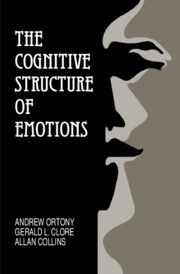Book contents
- Frontmatter
- Contents
- Preface
- 1 Introduction
- 2 The Structure of the Theory
- 3 The Cognitive Psychology of Appraisal
- 4 Factors Affecting the Intensity of Emotions
- 5 Reactions to Events: I
- 6 Reactions to Events: II
- 7 Reactions to Agents
- 8 Reactions to Objects
- 9 The Boundaries of the Theory
- References
- Author Index
- Subject Index
1 - Introduction
Published online by Cambridge University Press: 01 June 2011
- Frontmatter
- Contents
- Preface
- 1 Introduction
- 2 The Structure of the Theory
- 3 The Cognitive Psychology of Appraisal
- 4 Factors Affecting the Intensity of Emotions
- 5 Reactions to Events: I
- 6 Reactions to Events: II
- 7 Reactions to Agents
- 8 Reactions to Objects
- 9 The Boundaries of the Theory
- References
- Author Index
- Subject Index
Summary
Emotions have many facets. They involve feelings and experience, they involve physiology and behavior, and they involve cognitions and conceptualizations. There are important questions that can be asked about the expression of emotions, especially through the face, and the language of emotion constitutes an interesting research domain in its own right. In this book we are primarily interested in the contribution that cognition makes to emotion. The most general issue we shall address concerns the question of emotional differentiation–the question of what distinguishes one emotion from another–and our approach will be concerned more or less exclusively with trying to characterize the differences between emotions in terms of the different kinds of cognitions we take to be responsible for them. Taking the perspective of empirical psychology and cognitive science, we start with the assumption that emotions arise as a result of the way in which the situations that initiate them are construed by the experiencer. Our general plan is to try to impose some structure on the limitless number of possible emotion-eliciting situations. This is primarily an undertaking in theoretical psychology, although our proposals are intended to be consistent with existing data, as well as making their own empirically testable predictions. What we are trying to do, therefore, is to specify the “psychological” structure of emotions in terms of personal and interpersonal situation descriptions. Given these goals, we make no attempt to review the massive literature on the diverse aspects of the psychology of emotion.
Information
- Type
- Chapter
- Information
- The Cognitive Structure of Emotions , pp. 1 - 14Publisher: Cambridge University PressPrint publication year: 1988
Accessibility standard: Unknown
Why this information is here
This section outlines the accessibility features of this content - including support for screen readers, full keyboard navigation and high-contrast display options. This may not be relevant for you.Accessibility Information
- 2
- Cited by
